I know what some of you are thinking, but this is not a toy. In fact, the Wuling Air EV is perfectly usable as a daily car, despite the fact that it’s a pint-sized box powered by batteries. How do we know? Well, we borrowed one to zip around Jakarta, that’s how.
Yours truly stayed back in the Indonesian capital after our Gaikindo Indonesia International Auto Show (GIIAS) 2023 coverage for this. We arranged a tester from Carro Indonesia, which had this Wuling Air EV Long Range in its inventory. The car was to be picked up on a Monday morning at the used car retailer’s Pondok Indah HQ, and I would drive it around for a couple of hours.
Pretty straightforward, you’d think. I’ve driven in many countries over the course of work, but as I surveyed the chaotic ground from my temporary base in Blok M, doubt crept in. Jakarta’s traffic and difficulty level looks like something else, possibly second to only India’s roads in Asia?
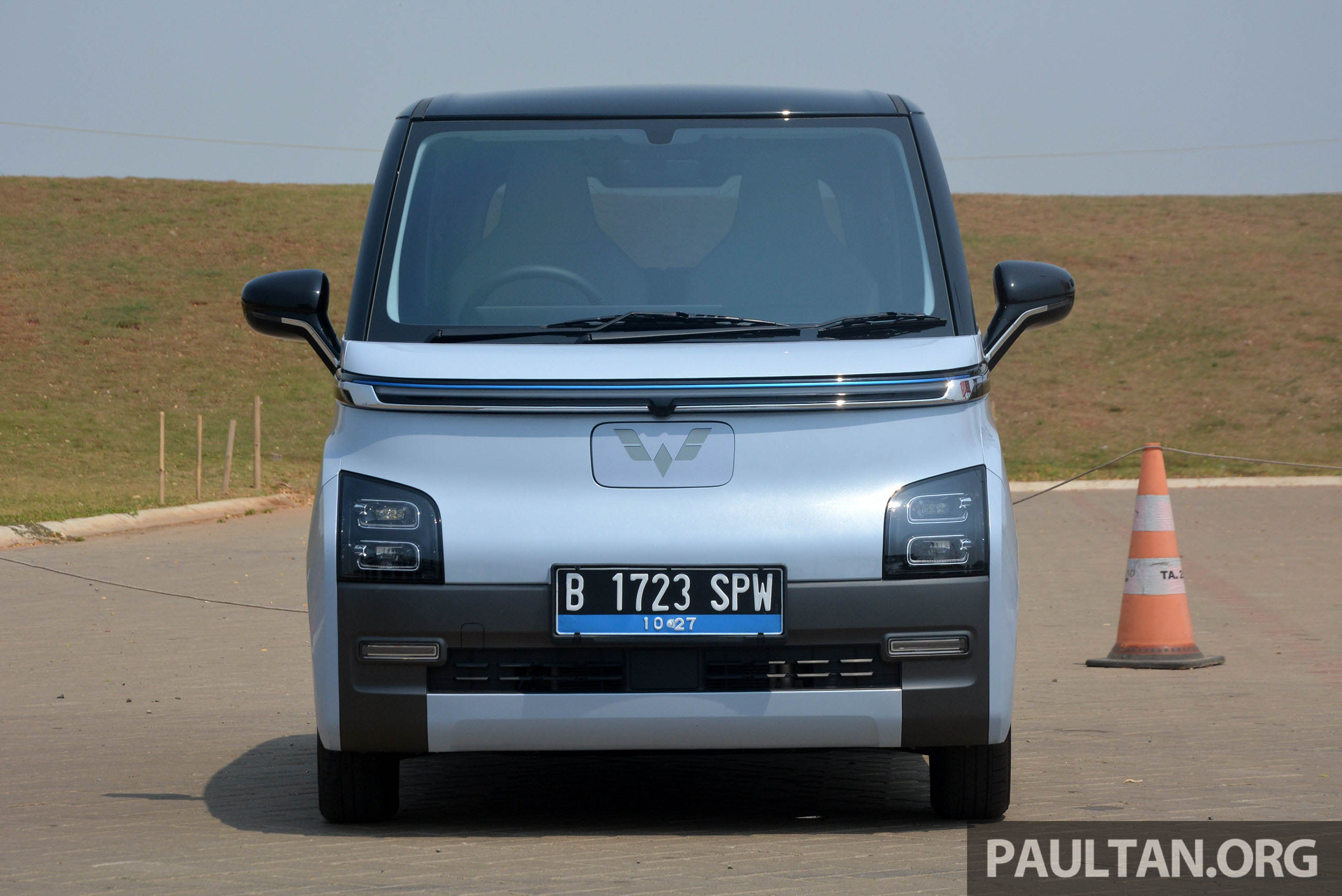
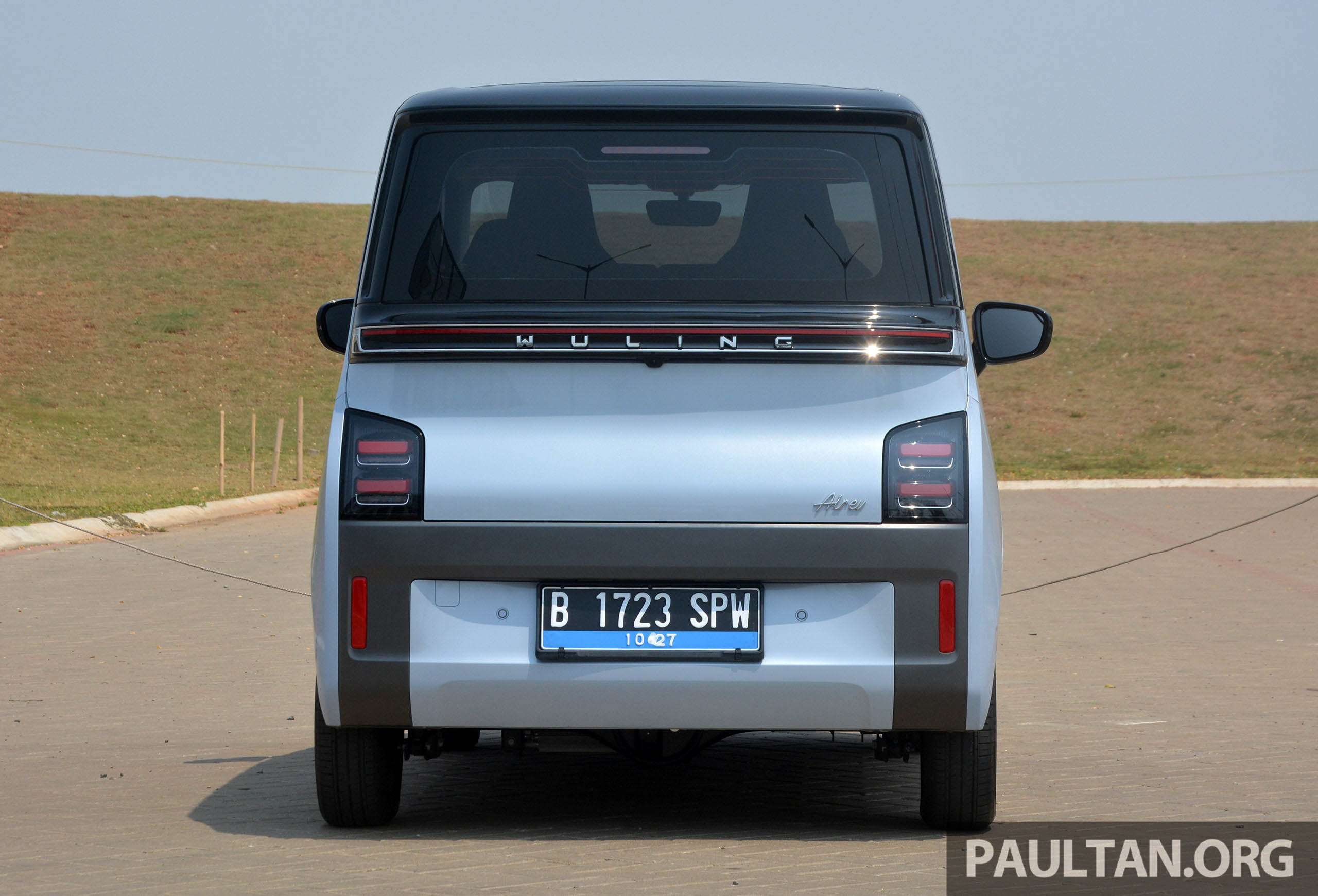
And unlike on media drives, I had to plan myself a route and navigate out of an unfamiliar city centre with crazy workday traffic. I also needed a decent photography spot (GIIAS teammate and photographer Sherman had left over the weekend to serve in the state elections). It looks like war out there, and my non-armoured personnel carrier is the tiniest in the field!
Why the Wuling, you ask. Well, it’s somewhat of a forbidden fruit for us, that’s why. Made in Indonesia and launched there last year, the little EV by SAIC-GM reached India (badged as the MG Comet there) and Thailand this year.
Everywhere it goes, the little Wuling is either the cheapest EV on sale or among the least expensive – in Indonesia, the three variant Air EV range is priced from Rp 188.9 juta (RM57,338) for the just-launched Lite to Rp 295 juta (RM89,543) for the Long Range you see here. In Thailand, the Indonesian-made Air EV is even cheaper – from 395k baht (RM52,288) for the Standard Range and 465k baht (RM61,561) for the Long Range.
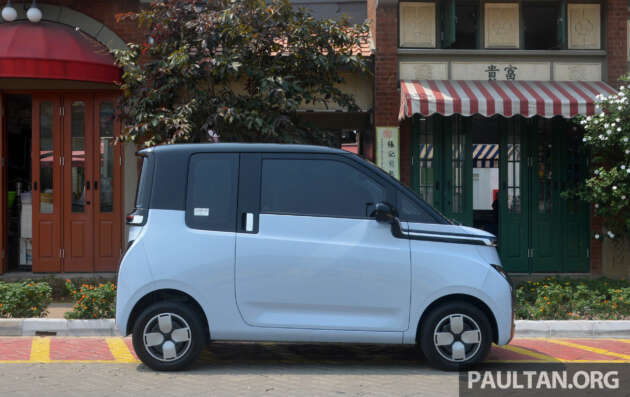
That’s Myvi money for an EV. The ‘problem’ for us then is Malaysia’s RM100k barrier for CBU imported EVs, which have to be priced higher than the century mark. That leaves some Chinese EVs looking like poor value (the Neta V is only RM72,688 in Thailand, for instance) and some without a business case – the Air EV’s USP is its small size and corresponding price.
If this barrier is lifted, will a car like the Air EV work in Malaysia? The exercise to shrink its size and battery to fit a price point – has that rendered the car unusable as a daily? A legit daily EV for Myvi money, or is the Wuling just a toy? Those are the questions I’m attempting to answer here.
First, specs. This cute little thing has a petite footprint of 2,974 mm by 1,505 mm, and its tiny 12-inch wheels (145/70 tyres!) are placed at the extreme corners for a wheelbase that’s 10 mm over two metres. It’s surprisingly tall though; at 1,631 mm, the Air EV is the same height as a Perodua Ativa (1,635 mm), which means it towers over regular small cars like the Axia. We parked it next to those two cars for you to have a better picture – check out the pics below.
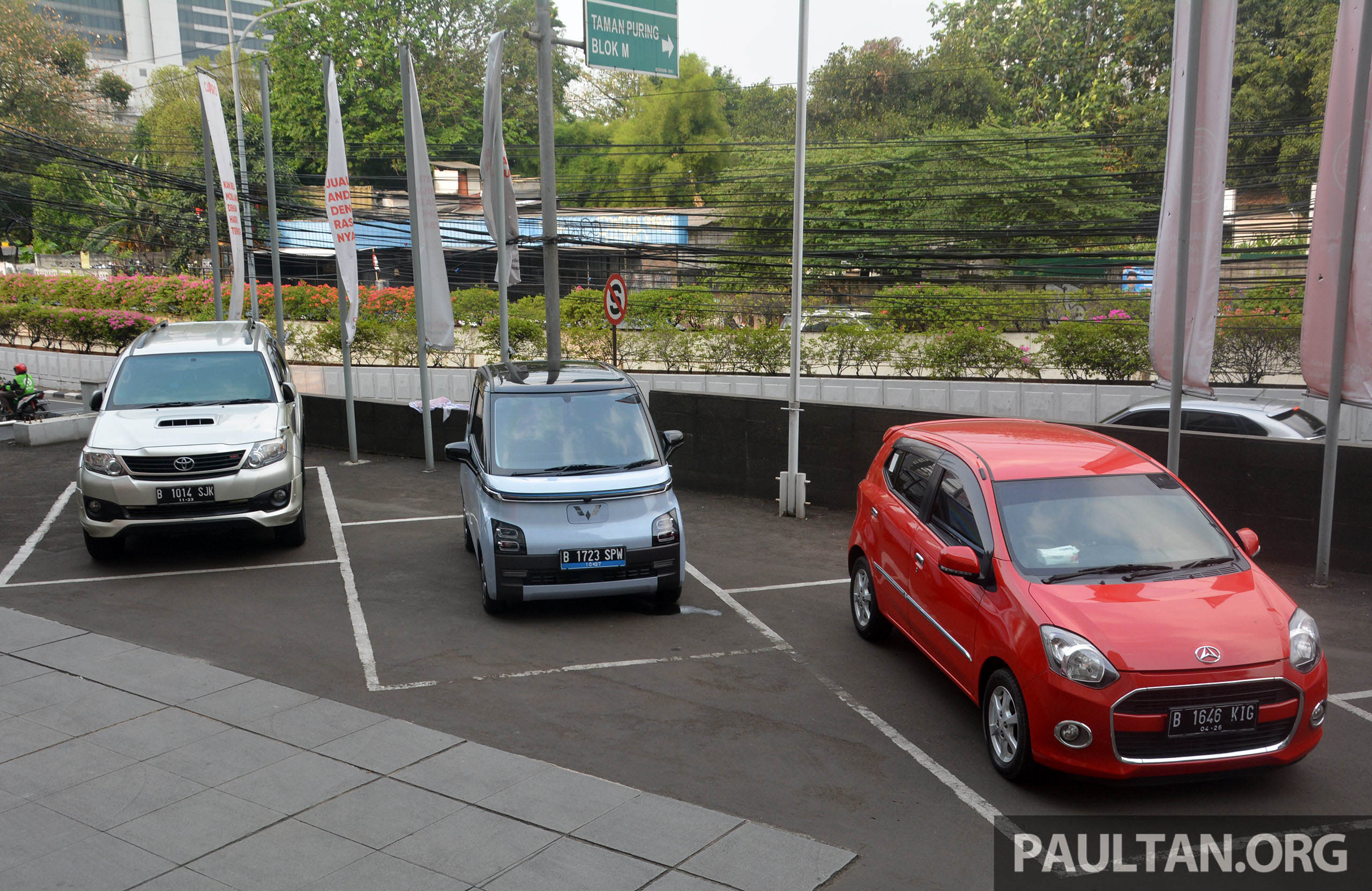
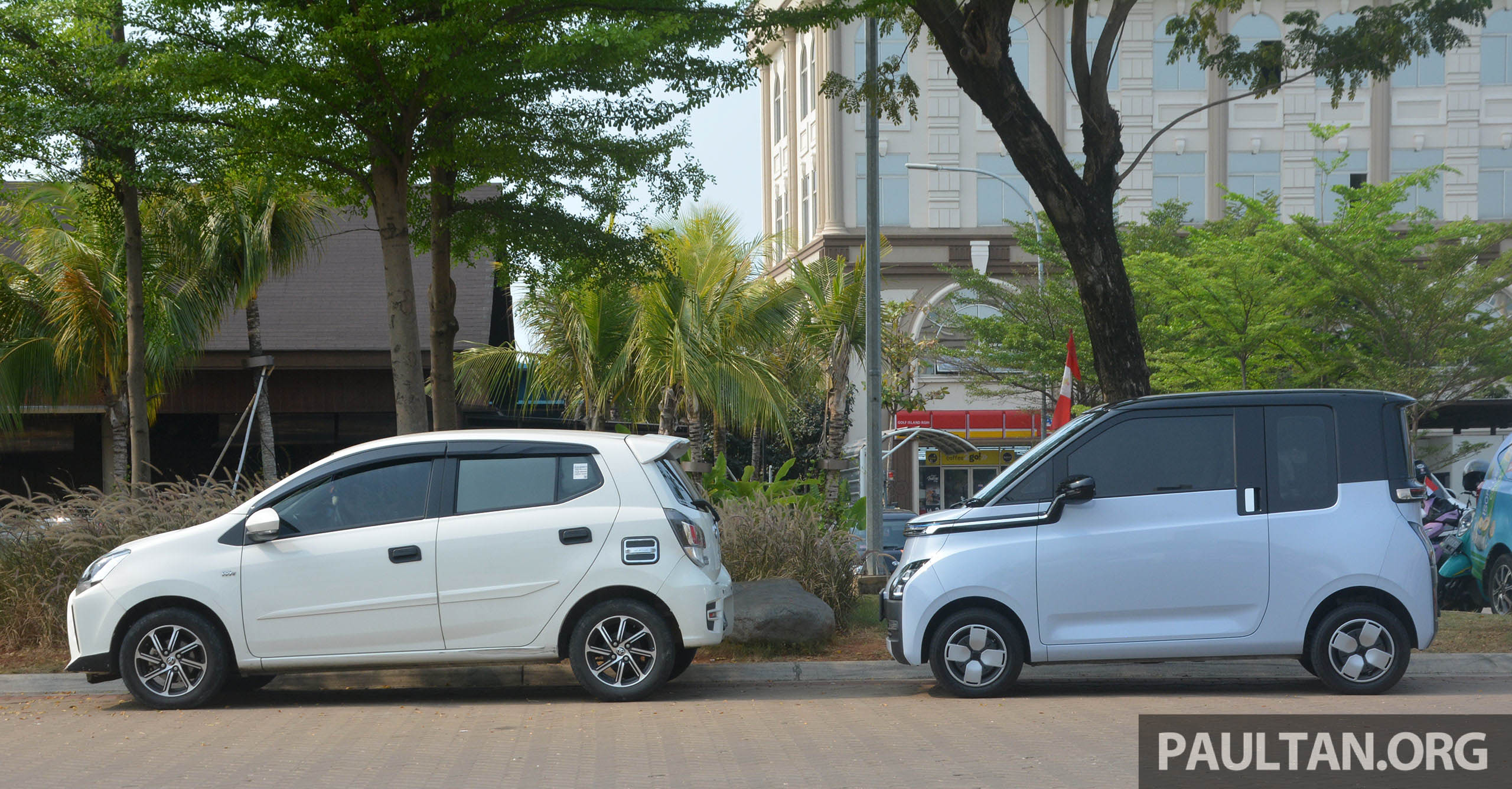
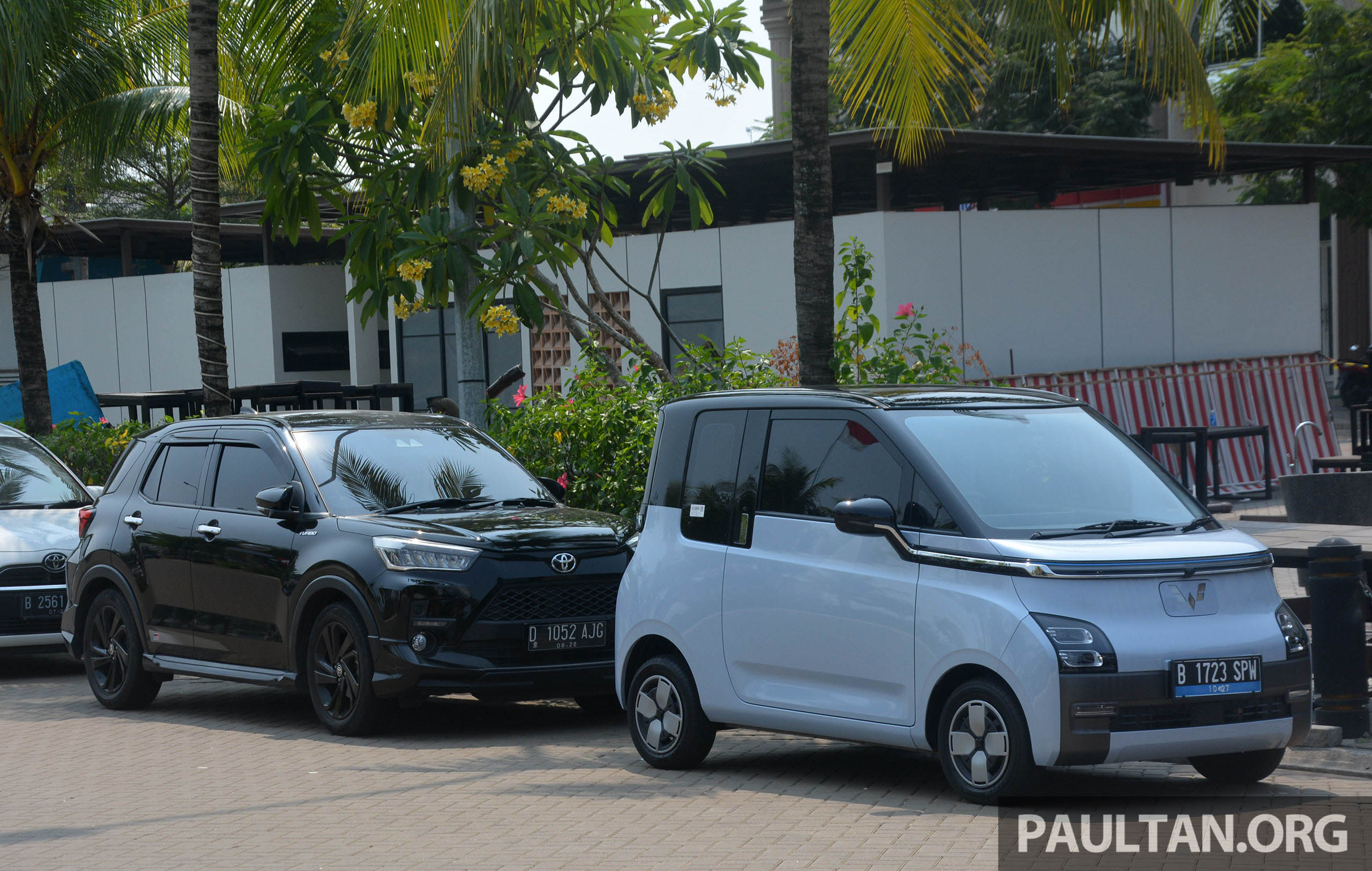
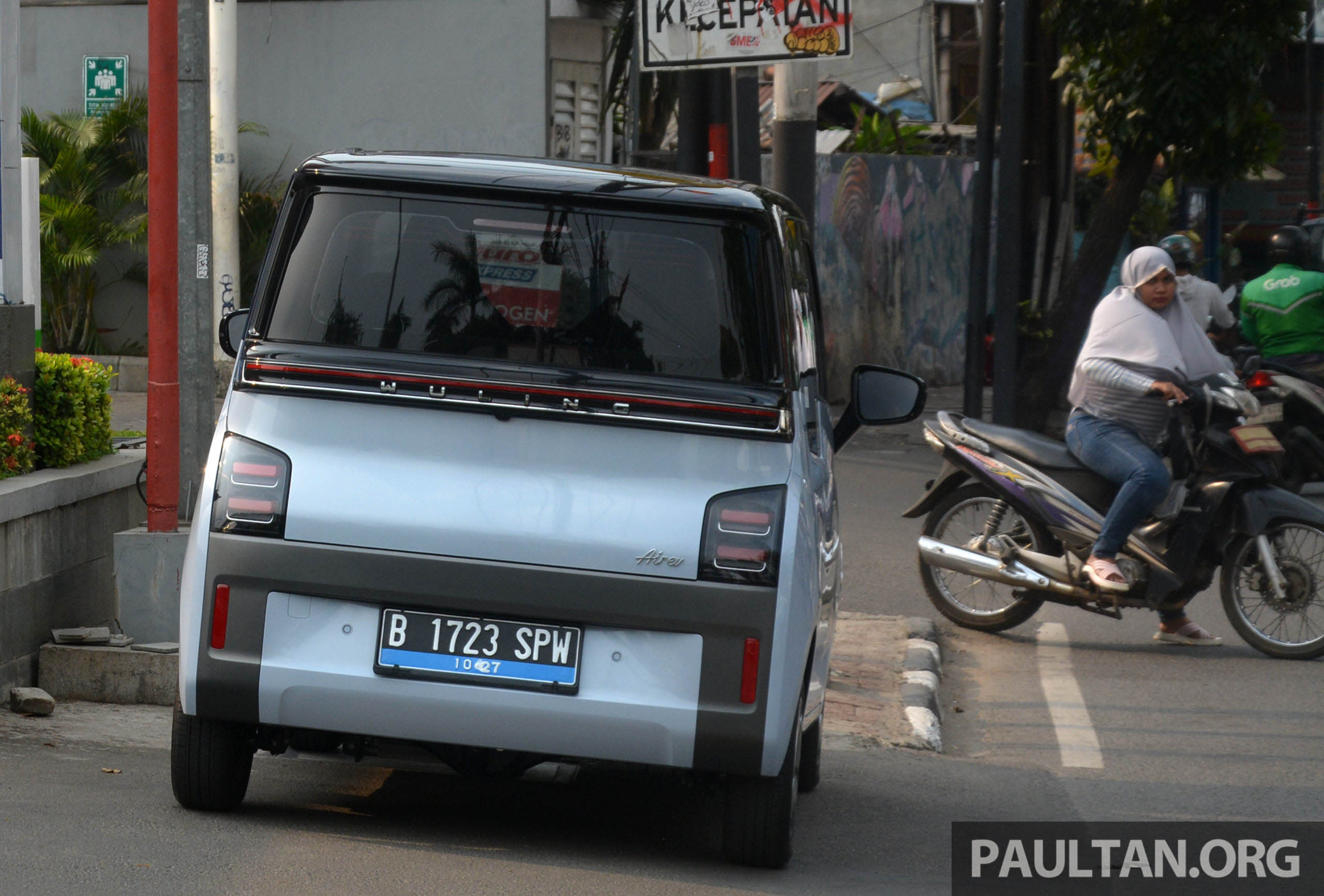
That substantial height combines with a boxy shape to give the Air EV a distinctive style that’s pretty original. That’s not something often said about car designs from China, but the Wuling Hongguang Mini EV – the Air EV’s elder sister – was a breath of fresh air when it debut in 2020, subsequently becoming a sales sensation and a much-copied template. Every Chinese brand had to have one – the Chery QQ Ice Cream and DFSK’s Seres E1 are just two examples. The latter was launched at GIIAS just next to Wuling’s stand.
Compared to the Hongguang Mini EV, the Air EV looks more fancy, more premium even, thanks to flair cues such as the full-width LED bars at both ends and the illuminated Wuling logo on the front charging flap – it’s distinctive, even when you can’t see the car.
The Air EV’s sides are flat but not featureless; the chrome strip that underlines the front LED bar goes all the way into the wing mirrors, and there’s a portrait rear window that goes deeper down than the other glass panels – this cute quirk brings real benefit to rear passengers.
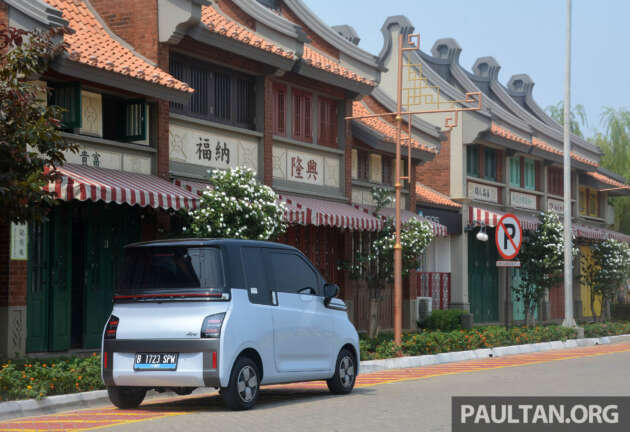
Cheap cars aren’t normally rich in design, but the Air EV is an exception. Likewise, modern Chinese cars often look decent but generic. Not this Wuling, which comes in trendy pastel colours that are easy on the eye. To mine, it’s a toss up between B 1723 SPW’s Galaxy Blue and Avocado Green for the best hue.
The Wuling’s imitable style is a revelation, literally, when you open the two doors to find four seats. The fact that they managed to squeeze four seats into this tiny footprint is surprising enough, so this writer was shocked to discover that he could easily fit into the rear seats with plenty of headroom to spare.
There’s ample room below the front chairs for feet to tuck into, knee room isn’t a problem for my 175 cm frame, and the above-mentioned long windows come in very handy, because there’s virtually no forward view for the rear passengers, not even between the front seats. It would have been very claustrophobic, and may still be so for some, but the porthole helps. There are grab handles too.
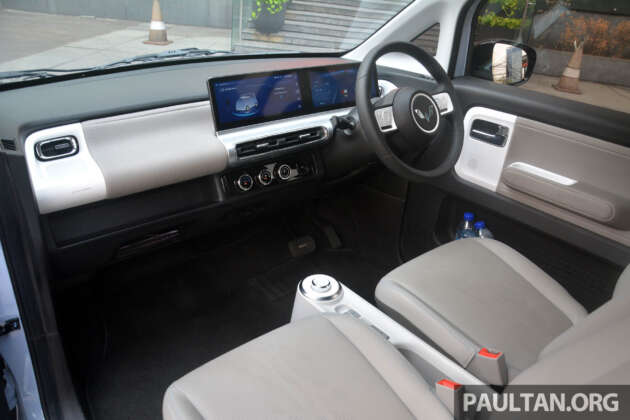
However, if the Air EV is to be a four seater, the humans better don’t come with any baggage, as remaining boot capacity is only good for a couple of 1.5L bottles with the seats up. Conversely, it’s great as a two-seater city car with a boot that can easily handle the weekly grocery haul. By the way, there’s a two-seater version of the Air EV in China; without the portrait window, its wheelbase is 357 mm shorter and it looks really funny.
If the Air EV’s exterior looks like some sci-fi movie future pod, its cockpit looks modern and minimalistic too. Yes, it has the conjoined screens made popular by Mercedes-Benz, but the pared-down layout and interesting material mix is rather refreshing. Gloss white trim is very prominent; that and the steering buttons might remind some of the Apple iPod.
Minimal it may look, but there are plenty of nooks for your daily carry. There’s an obvious long tray facing the passenger, but the underside of the dashboard hides a netted hole and two tapau hooks. Wallets, pouches and small bags can fit into the slot between the seats, but it’s the door pockets that surprise. It’s so long, you can open a drinks stall with this car. No glove box, though.
Bisa jalan? Ok pak. My starting point was Carro Square in Pondok Indah, and I chose Pantai Indah Kapuk (PIK) as my destination, specifically the reclaimed Golf Island. I needed a highway run and the 25 km Jakarta Outer Ring Road route to the shore would provide that. From one affluent hood to another with upscale F&B would be a realistic journey for an EV-driving Jakartan, I suppose?
The good folks at Carro juiced up the Wuling for me and I set off with 88% charge, good for 264 km according to the trip meter. By the way, this is the range-topping Long Range, which has a 26.7 kWh lithium ferro-phosphate (LFP) battery and a claimed range of 300 km. This is likely to be a CLTC figure, which should translate to a WLTP range in the low 200s. Because of the battery’s modest size, AC charging at 6.6 kW takes just four hours.
Google Maps fired up, I took baby steps into Jakarta’s traffic and realised, after a few wrong turns, that despite the audio visual chaos, motorists are actually less aggressive than those back home. There’s an unspoken ‘give and take’ to the flow (don’t hesitate, gentle horn when needed), a bit like in Thailand. And this is despite there being so many kapcais buzzing around. Malaysia? Our roads may look good, but the approach is ‘take no quarter’.
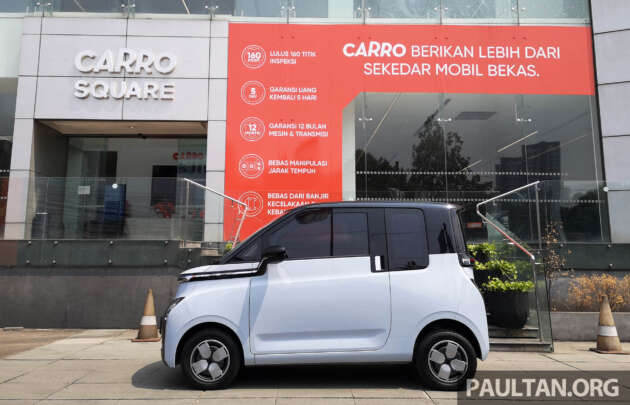
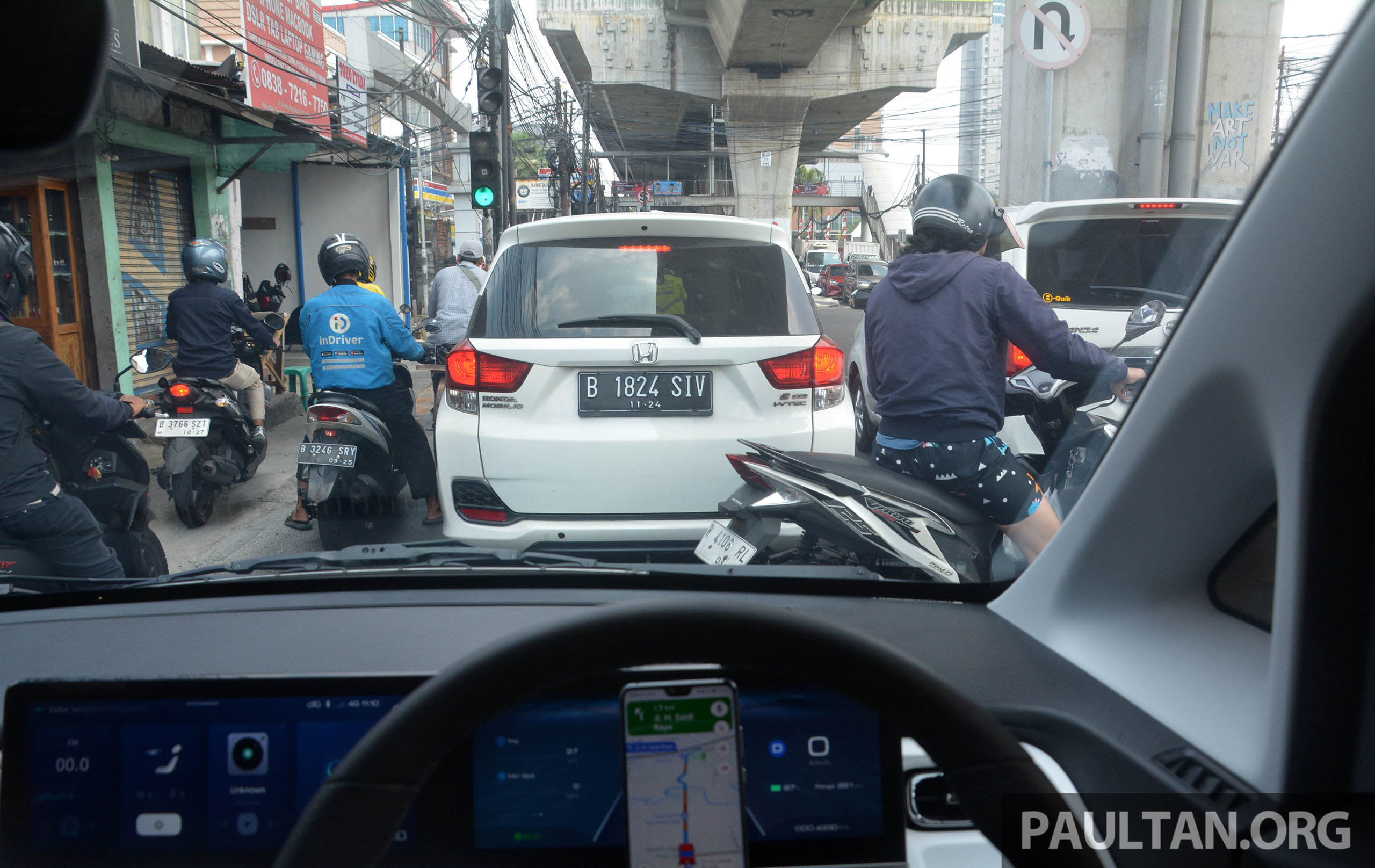
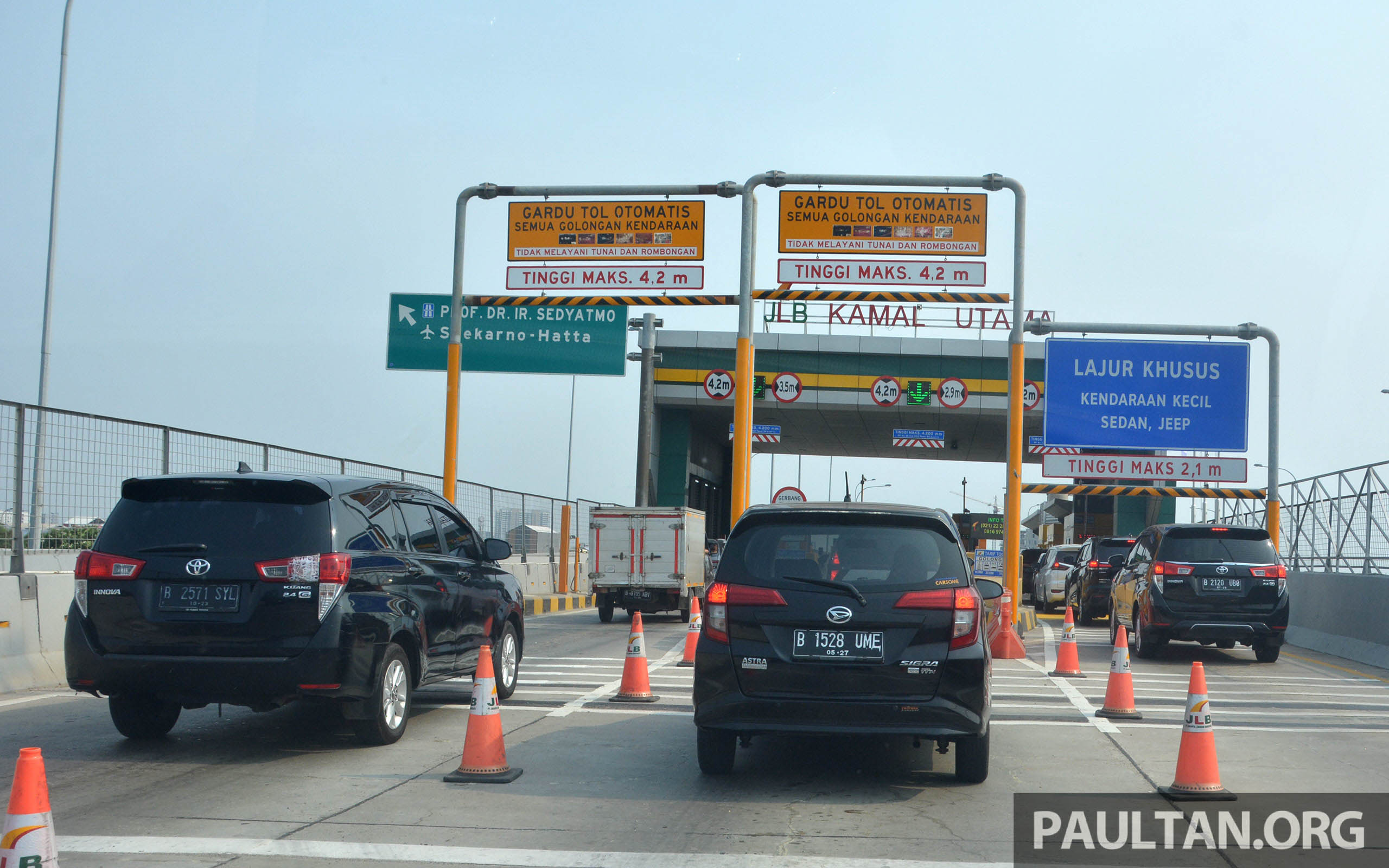
Eco mode is adequate in crawling traffic and with the regeneration set at ‘strong’, I single pedalled all the way to the highway. In the section before the JORR toll, I appreciated the Wuling’s narrow body, which allowed me to share the lane with bikes, with some buffer. The lack of a bonnet allows you to get hilariously close to the car in front, making me wonder how much space society will save if we all drove one of these.
Of course, the Air EV is easy to park and drive, and you’d expect fantastic visibility from the large glass area. I did too, but in practice, you sit really high up and are effectively looking down on the road. Even though the Wuling is tall and I’m not the tallest guy around (175 cm), my eye level is the top 10% of the windscreen. Like in the Proton Satria Neo but with headroom.
Seat comfort isn’t the best (upper seat back felt far from my body) and the driving position is just about doable for me (no telescopic). The driver’s side wing mirror had severe reflection of the white dash trim, which didn’t help this Jakarta newbie’s cause. It could be the window tint, I’m not sure. Yours truly also did not like the rear view mirror’s heavy fish eye effect and the lack of a left foot rest.
EVs are commonly described as silent, but they’re not – they just produce a different kind of sound from ICE cars. In this most basic of EVs, you’re accompanied by a constant and pretty loud wheeze plus ‘wooo’ sound, a different kind of two-tone. In fact, I think that a modern B-segment car might have less powertrain noise. But you’ll get used to it, like I did in just a few hours.
After entering the highway at Ciledug, I switched to Normal mode and cruised at 70 to 80 km/h, mixing it with the trucks in the slower lanes. We’re used to EVs having explosive off-the-line acceleration, but you won’t get that from the Air EV’s rear-mounted 41 PS (30 kW) e-motor. But pick-up is smooth and I found performance to be adequate for what it is, a city car.
I was expecting Little Ling to be a bit shaken by passing fast cars and big lorries, but it’s planted and steady on the highway. However, if you’re coming from a B-segment car, say a Toyota Yaris, the high-speed ride will be a bit rodeo and the low-speed ride less damped than what you’re used to. Once again, it’s not bad for a car with such small wheels and a short wheelbase.
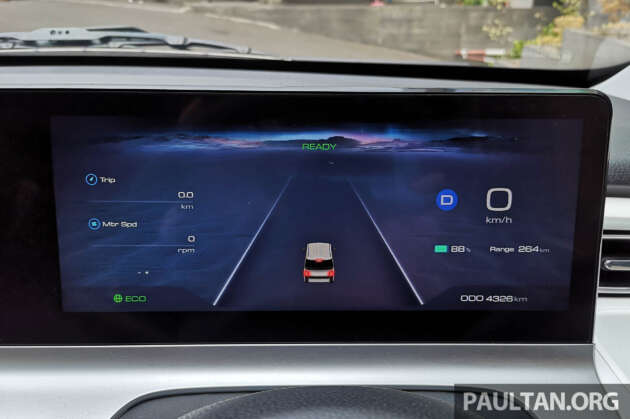
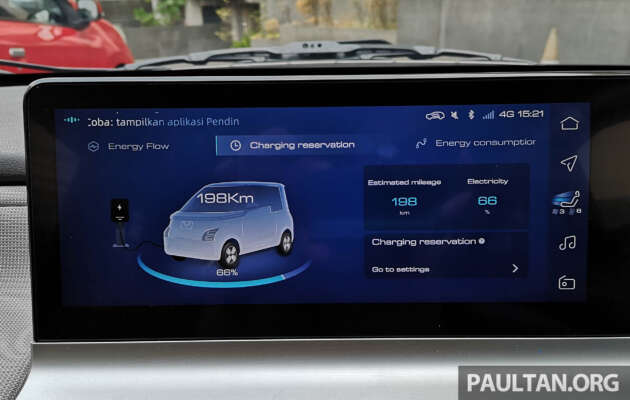
A pleasant surprise came by way of the steering. It’s light and easy, as it should be, but the wheel also had more road feel than expected, making the Wuling a more natural-feeling steer than some Chinese EVs in our market.
After lunch, the photoshoot and much needed coffee, I headed back to the city from PIK, driving faster than the journey north as I had plenty of range to spare. The final score at Carro Square was 66% SoC and 198 km of remaining range. I had travelled 62.2 km, which consumed 22% of charge. That’s a decent return, and I wasn’t even trying. In fact, with nearly 200 km left in the ‘tank’, I could do three more similar runs before the Air EV needed recharging.
So, I survived driving in Jakarta and the Wuling surprised me. Would I adopt one if it was available in Malaysia for Myvi money? It’s almost a yes, because the Air EV is capable of a weekend of jalan-jalan cari makan with a full charge, something the MINI Electric struggles do with its sub-170 km real world range from 80% SoC. I do less than 40 km a day on weekdays, which means that a single charge can last me the entire work week. Also, the LFP battery can be charged to 100% without accelerating degradation, so you’ll get to milk every drop of that 26.7 kWh pack.
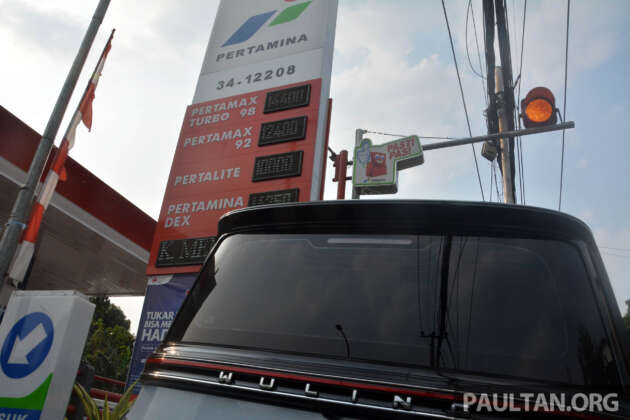
Almost a yes? I live in an apartment and therefore have no access to home charging, which is more important than the public charging infrastructure everyone talks about. Furthermore, petrol in Malaysia is cheap, which means that there’s no push factor. I stopped at a local Pertamina to check the price of BBM, and RON 92 petrol is currently going for Rp 12,400 per litre, which is RM3.76. That’s real world fuel prices for you, Malaysians. Of course, none of this is the Wuling’s fault.
It’s not perfect and there are some shortcomings in ergonomics, but there’s a lot to like about the Wuling Air EV. It might look like a toy, but is in fact a proper ‘dailiable’ electric car. It looks tiny, yet is a proper four-seater. The pastel-coloured icing on the cake is design – the Air EV is distinctive, cute and perhaps a bit desirable too. Our loss.
GALLERY: Wuling Air EV Long Range in Jakarta
GALLERY: Wuling Air EV Long Range at GIIAS 2023
Looking to sell your car? Sell it with myTukar.



